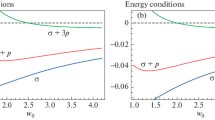Abstract
We investigate the stability regions of the thin-shells obtained by gluing the exterior Schwarzschild vacuum with two distinct classes of Ellis wormholes, one with zero and the other with nonzero total mass. Using the new concepts of thin-shell “mass” and of “external force” discovered recently by Garcia, Lobo and Visser, we shall apply their method to the explicit cases where some of the energy conditions in the bulk (on two sides) are violated. The stability regions are analyzed and the energetics is briefly discussed. Remarkably, we find that the stability zones are quite similar although the classes of Ellis wormholes are different. By the present examples, we confirm that the stability zones indicated by the force constraint (involving Φ and its derivatives) are more complete but restrictive than those from the mass constraint (not involving Φ).




Similar content being viewed by others
Notes
There is a ruse here in the literature. Ellis takes ε=+2, and a real φ. Together, they contribute a positive sign before the source stress term, which cannot lead to his “drainhole”. Actually, ε=+2 should be taken with imaginary φ, or, alternatively, ε=−2 should be taken with real φ. In either case, there results a negative sign before the source stress term leading to energy condition violations necessary for drainhole or wormhole topology (in modern terminology). We take ε=−1, and real φ.
It is very important to be careful with the choice of the volume measure. For instance, if we naïvely take the measure as exactly in the metric (2), viz., 4π(l 2+m 2)dl, and integrate, we shall end up with
$$\varOmega_{NEC}^{bothsides} = \frac{1}{8\pi} \int _{ - \infty}^{\infty} \rho_{\phi} \cdot 4\pi r^{2} \bigl( l^{2} + m^{2} \bigr)dl = - \pi m, $$which does not reflect the zero total mass! The correct volume measure is 4πr 2 dr as used in the text.
We thank an anonymous reviewer for suggesting this problem.
The original solution is the Class IV Brans solution that can be rewritten in isotropic coordinates (t,r,θ,φ) in the Einstein conformally rescaled frame as [9, 27] dτ 2=−e −2m/ρ dt 2+e 2m/ρ[dρ 2+ρ 2 dΩ 2]. This is the Class II wormhole (or drainhole, as he termed it) found independently by Ellis [9]. We have cast it here in the MT form, as suggested.
References
Garcia, N.M., Lobo, F.S.N., Visser, M.: Phys. Rev. D 86, 044026 (2012)
Visser, M.: Nucl. Phys. B 328, 203 (1989)
Poisson, E., Visser, M.: Phys. Rev. D 52, 7318 (1995)
Visser, M.: Phys. Lett. B 242, 24 (1990)
Eiroa, E.F., Romero, G.E.: Gen. Relativ. Gravit. 36, 651 (2004)
Lobo, F.S.N., Crawford, P.: Class. Quantum Gravity 21, 391 (2004)
Visser, M.: Lorentzian Wormholes: From Einstein to Hawking. American Institute of Physics, New York (1995). See the treatise for a comprehensive treatment
Ishak, M., Lake, K.: Phys. Rev. D 65, 044011 (2002)
Ellis, H.G.: J. Math. Phys. 14, 104 (1973)
Cattoen, C., Faber, T., Visser, M.: Class. Quantum Gravity 22, 4189 (2005)
Lobo, F.S.N.: Class. Quantum Gravity 23, 1525 (2006)
Lobo, F.S.N., Arellano, A.V.B.: Class. Quantum Gravity 24, 1069 (2007)
Visser, M., Wiltshire, D.L.: Class. Quantum Gravity 21, 1135 (2004)
Mazur, P.O., Mottola, E.: Proc. Natl. Acad. Sci. USA 101, 9545 (2004)
Martin-Moruno, P., Garcia, N.M., Lobo, F.S.N., Visser, M.: J. Cosmol. Astropart. Phys. 1203, 034 (2012)
Clément, G.: Int. J. Theor. Phys. 23, 335 (1984)
Bhattacharya, A., Potapov, A.A.: Mod. Phys. Lett. A 25, 2399 (2010)
Nakajima, K., Asada, H.: Phys. Rev. D 85, 107501 (2012)
Perlick, V.: Phys. Rev. D 69, 064017 (2004)
Dey, T.K., Sen, S.: Mod. Phys. Lett. A 23, 953 (2010)
Nandi, K.K., Zhang, Y.-Z., Zakharov, A.V.: Phys. Rev. D 74, 024020 (2006)
Abe, F.: Astrophys. J. 725, 787 (2010)
Lynden-Bell, D., Katz, J., Bičák, J.: Phys. Rev. D 75, 024040 (2007). Erratum, ibid, D 75, 044901 (2007)
Katz, J., Lynden-Bell, D., Bičák, J.: Class. Quantum Gravity 23, 9111 (2006)
Morris, M.S., Thorne, K.S.: Am. J. Phys. 56, 395 (1988)
Nandi, K.K., Zhang, Y.-Z.: Phys. Rev. D 70, 044040 (2004)
Nandi, K.K., Bhattacharjee, B., Alam, S.M.K., Evans, J.: Phys. Rev. D 57, 823 (1998)
Acknowledgements
This work was supported in part by an internal grant of M. Akmullah Bashkir State Pedagogical University on natural sciences field.
We thank the anonymous referees for their insightful comments that helped us improve the manuscript considerably.
Author information
Authors and Affiliations
Corresponding author
Rights and permissions
About this article
Cite this article
Khaybullina, A., Akhtaryanova, G., Mingazova, R. et al. Stability of the Thin-Shell Schwarzschild-Ellis Wormhole. Int J Theor Phys 53, 1590–1600 (2014). https://doi.org/10.1007/s10773-013-1957-9
Received:
Accepted:
Published:
Issue Date:
DOI: https://doi.org/10.1007/s10773-013-1957-9




